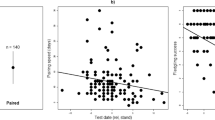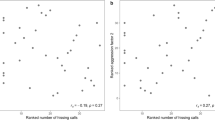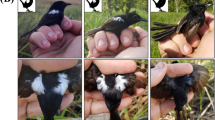Abstract
Female-female aggression and its effect on fitness are poorly understood compared to male-male aggression. We quantified female-female aggression in the viviparous toad-headed agama, Phrynocephalus vlangalii, and tested the mate limitation and resource competition hypotheses, to explain the driving forces behind heightened female-female aggression. We established populations in outdoor enclosures and separately manipulated mate and food availability while quantifying aggressive interactions between known females. Female mass and offspring quantity and quality were monitored for 2 years and used as an index of female fitness. Interestingly, female-female aggression was highest outside the mating season, when females were pregnant. Also, male availability did not significantly influence female-female aggression. Consequently, we found no evidence in support of the mate limitation hypothesis. Female-female aggression, however, was greatest during periods of low-food availability. Greater food availability did have positive fitness consequence for females: high-food treatment females were more likely to gain mass and give birth than females from the low-food treatment, and offspring from high-food treatment females were more likely to survive the first winter. However, we did have an effect of year: female mass was negatively associated with female-female aggression in year 1 but positively associated in year 2, although the association was not significant. The same pattern appeared in the association between offspring sprint speed and female-female aggression: higher levels of female-female aggression in year 1 were associated with slower offspring, while in year 2, higher female-female aggression was associated with faster offspring. Overall, our results demonstrate a link between female-female aggression and competition for resource (food) and highlight the potential importance of female aggressive behavior as a mechanism that influences female fitness.
Significance statement
Male-male contest competition has been a cornerstone of sexual selection theory for decades because dominant males can control more space and access to females. Conversely, female aggression is poorly understood and sometimes considered a paradox, especially in species lacking parental care. We tested whether female-female aggression in the viviparous lizard P. vlangalii is best explained by competition for males (mate limitation hypothesis) or competition over food (food limitation hypothesis). Interestingly, female aggression peaks after mating, while females are still pregnant. Heightened aggression at this time supports the food limitation hypothesis because any advantage females have in terms of access to resources will benefit offspring born into her home range. Likewise, access to additional food resources may improve female survival and future reproductive investment through greater energy storage.



Similar content being viewed by others
Data availability
The datasets generated during and/or analyzed during the current study are available on Figshare https://doi.org/10.6084/m9.figshare.7375829.v1.
References
Bateman AJ (1948) Intra-sexual selection in Drosophila. Heredity 2:349–368
Bates D, Mächler M, Bolker B, Walker S (2015) Fitting linear mixed-effects models using lme4. J Stat Softw 67:1–48
Bebié N, Mcelligott AG (2006) Female aggression in red deer: does it indicate competition for mates? Mamm Biol 71:347–355
Cain KE, Ketterson ED (2012) Competitive females are successful females; phenotype, mechanism and selection in a common songbird. Behav Ecol Sociobiol 66:241–252
Cain KE, Langmore NE (2015) Female and male song rates across breeding stage: testing for sexual and nonsexual functions of female song. Anim Behav 109:65–71
Clotfelter ED, O'Neal DM, Gaudioso JM, Casto JM, Parker-Renga IM, Snajdr EA, Duffy DL, Nolan V, Ketterson ED (2004) Consequences of elevating plasma testosterone in females of a socially monogamous songbird: evidence of constraints on male evolution? Horm Behav 46:171–178
Clutton-Brock T (2009) Sexual selection in females. Anim Behav 77:3–11
Clutton-Brock T, Huchard E (2013) Social competition and its consequences in female mammals. J Zool 289:151–171
Cooper WE, Dimopoulos I, Pafilis P (2015) Sex, age, and population density affect aggressive behaviors in island lizards promoting cannibalism. Ethology 121:260–269
Eggert AK, Otte T, Müller JK (2008) Starving the competition: a proximate cause of reproductive skew in burying beetles (Nicrophorus vespilloides). Proc R Soc Lond B 275:2521–2528
Ellegren H, Parsch J (2007) The evolution of sex-biased genes and sex-biased gene expression. Nat Rev Genet 8:689–698
Elston DA, Moss R, Boulinier T, Arrowsmith C, Lambin X (2001) Analysis of aggregation, a worked example: numbers of ticks on red grouse chicks. Parasitology 122:563–569
Fisher ML (2004) Female intrasexual competition decreases female facial attractiveness. Proc R Soc Lond B 271:S283–S285
Forsgren E, Amundsen T, Borg ÅA, Bjelvenmark J (2004) Unusually dynamic sex roles in a fish. Nature 429:551–554
Forstmeier W, Martin K, Bolund E, Schielzeth H, Kempenaers B (2011) Female extrapair mating behavior can evolve via indirect selection on males. Proc Natl Acad Sci USA 108:10608–10613
Gebhardt-Henrich S, Richner H (1998) Causes of growth variation and its consequences for fitness. In: Starck JM, Ricklefs RE (eds) Avian growth and development. Oxford University Press, New York, pp 324–339
Gill SA, Alfson ED, Hau M (2007) Context matters: female aggression and testosterone in a year-round territorial neotropical songbird (Thryothorus leucotis). Proc R Soc Lond B 274:2187–2194
Haenel GJ, John-Alder HB (2002) Experimental and demographic analyses of growth rate and sexual size dimorphism in a lizard, Sceloporus undulatus. Oikos 96:70–81
Huchard E, Cowlishaw G (2011) Female–female aggression around mating: an extra cost of sociality in a multimale primate society. Behav Ecol 22:1003–1011
Kvarnemo C, Forsgren E, Magnhagen C (1995) Effects of sex ratio on intra- and inter-sexual behaviour in sand gobies. Anim Behav 50:1455–1461
Lande R (1980) Sexual dimorphism, sexual selection, and adaptation in polygenic characters. Evolution 34:292–305
Lewis SM, Rooney JA (2004) Nuptial gifts and sexual selection in Photinus fireflies. Integr Comp Biol 44:234–237
Losos JB, Creer DA, Schulte JA (2002) Cautionary comments on the measurement of maximum locomotor capabilities. J Zool 258:57–61
Mangiamele LA, Fuxjager MJ, Schuppe ER, Taylor RS, Hödl W, Preininger D (2016) Increased androgenic sensitivity in the hind limb muscular system marks the evolution of a derived gestural display. Proc Natl Acad Sci USA 113:5664–5669
Martin P, Bateson P (2007) Measuring behaviour an introductory guide. Cambridge University Press, New York
Mcginley RH, Taylor PW (2016) Video playback experiments support a role for visual assessment of opponent size in male-male contests of Servaea incana jumping spiders. Behav Ecol Sociobiol 70:821–829
O'Neal DM, Reichard DG, Pavilis K, Ketterson ED (2008) Experimentally-elevated testosterone, female parental care, and reproductive success in a songbird, the Dark-eyed Junco (Junco hyemalis). Horm Behav 54:571–578
Peters RA, Ramos JA, Hernandez J, Wu Y, Qi Y (2016) Social context affects tail displays by Phrynocephalus vlangalii lizards from China. Sci Rep 6:31573
Qi Y, Li S, Suo L, Li H, Wang Y (2011) An ethogram of the toad-headed lizard Phrynocephalus vlangalii during the breeding season. Asian Herpetol Res 2:110–116
Qi Y, Noble DW, Fu J, Whiting MJ (2012) Spatial and social organization in a burrow-dwelling lizard (Phrynocephalus vlangalii) from China. PLoS One 7:e41130
Qi Y, Noble DW, Wu Y, Whiting MJ (2014) Sex- and performance-based escape behaviour in an Asian agamid lizard, Phrynocephalus vlangalii. Behav Ecol Sociobiol 68:2035–2042
R Development Core Team (2011) R: a language and environment for statistical computing. R Foundation for Statistical Computing, Vienna, Austria, http://www.R-project.org
Rosvall KA (2008) Sexual selection on aggressiveness in females: evidence from an experimental test with tree swallows. Anim Behav 75:1603–1610
Rosvall KA (2011) Intrasexual competition in females: evidence for sexual selection? Behav Ecol 22:1131–1140
Rosvall KA (2013a) Life history trade-offs and behavioral sensitivity to testosterone: an experimental test when female aggression and maternal care co-occur. PLoS One 8:e54120
Rosvall KA (2013b) Proximate perspectives on the evolution of female aggression: good for the gander, good for the goose? Philos Trans R Soc B 368:20130083
Sandell MI (1998) Female aggression and the maintenance of monogamy: female behaviour predicts male mating status in European starlings. Proc R Soc Lond B 265:1307–1311
Sandell MI (2007) Exogenous testosterone increases female aggression in the European starling (Sturnus vulgaris). Behav Ecol Sociobiol 62:255–262
Sandell MI, Smith HG (1997) Female aggression in the European starling during the breeding season. Anim Behav 53:13–23
Seebacher F, Ward AJ, Wilson RS (2013) Increased aggression during pregnancy comes at a higher metabolic cost. J Exp Biol 216:771–776
Sinn DL, While GM, Wapstra E (2008) Maternal care in a social lizard: links between female aggression and offspring fitness. Anim Behav 76:1249–1257
Stockley P, Bro-Jørgensen J (2011) Female competition and its evolutionary consequences in mammals. Biol Rev 86:341–366
Stockley P, Campbell A (2013) Female competition and aggression: interdisciplinary perspectives. Philos Trans R Soc B 368:20130073
Swenson RO (1997) Sex-role reversal in the tidewater goby, Eucyclogobius newberryi. Environ Biol Fish 50:27–40
Thompson MB, Speake BK (2006) A review of the evolution of viviparity in lizards: structure, function and physiology of the placenta. J Comp Physiol B 176:179–189
Tobias JA, Montgomerie R, Lyon BE (2012) The evolution of female ornaments and weaponry: social selection, sexual selection and ecological competition. Philos Trans R Soc B 367:2274–2293
Trivers R (1972) Parental investment and sexual selection. In: Campbell B (ed) Sexual selection and the descent of man. Heinemann, London, pp 136–179
While GM, Sinn DL, Wapstra E (2009) Female aggression predicts mode of paternity acquisition in a social lizard. Proc R Soc Lond B 276:2021–2029
Whiting MJ, Stuart-Fox DM, O'Connor D, Firth D, Bennett NC, Blomberg SP (2006) Ultraviolet signals ultra-aggression in a lizard. Anim Behav 72:353–363
Wu PF, Wang YZ, Wang SG, Zeng T, Cai HX, Guo HY, Zeng ZY (2002) The age structure and sex ratio of Phrynocephalus vlangalii (Sauria: Agamidae). J Sichuan U 39:1134–1139
Wu PF, Zeng ZY, Wang YZ, Zhu B (2005) A new method for investigating Phrynocephalus vlangalii population density. Chin J Ecol 24:1241–1244
Wu Y, Fu J, Yue B, Yin Q (2015) An atypical reproductive cycle in a common viviparous Asia Agamid Phrynocephalus vlangalii. Ecol Evol 5:5138–5147
Yasukawa K, Searcy WA (1982) Aggression in female red-winged blackbirds: a strategy to ensure male parental investment. Behav Ecol Sociobiol 11:13–17
Acknowledgments
We are grateful to Er Ga and Cuo ke for logistical assistance in Zoige. Thanks to Xintao Deng for assistance with data collection in the field and Daniel Noble for advice on statistical methods. We thank two anonymous reviewers for their constructive comments that improved this manuscript.
Funding
This project was supported by grants from the National Natural Science Foundation of China to YQ (grant numbers 31201723, 31572273, 31872233) and to YW (grant number 31801980).
Author information
Authors and Affiliations
Corresponding author
Ethics declarations
Conflict of interest
The authors declare that they have no conflict of interest.
Ethical approval
We obtained the appropriate permissions for conducting the study at the Xiaman Conservation Station in the Zoige Wetland Nature Reserve from the Forestry Department of the Sichuan Provincial Government and the Management Office of the Zoige Nature Reserve. Handing of lizards followed approved protocols from the Experimental Animal Ethics Committee of the Chengdu Institute of Biology, Chinese Academy of Sciences (protocol number 2017005). We also adhered to the ABS/ASAB “Guidelines for the treatment of animals in behavioral research and teaching.”
Additional information
Communicated by S. J. Downes
Publisher’s note
Springer Nature remains neutral with regard to jurisdictional claims in published maps and institutional affiliations.
Electronic supplementary material
Appendix S1.
Outdoor, semi-natural enclosures used in mate limitation and food competition experiments. (DOCX 498 kb)
Rights and permissions
About this article
Cite this article
Wu, Y., Whiting, M.J., Fu, J. et al. The driving forces behind female-female aggression and its fitness consequence in an Asian agamid lizard. Behav Ecol Sociobiol 73, 73 (2019). https://doi.org/10.1007/s00265-019-2686-8
Received:
Revised:
Accepted:
Published:
DOI: https://doi.org/10.1007/s00265-019-2686-8




